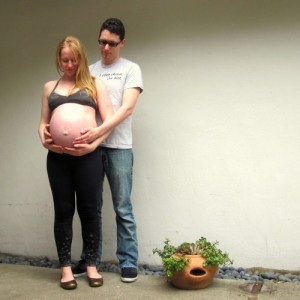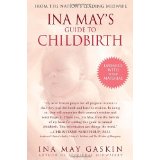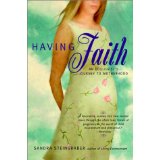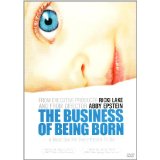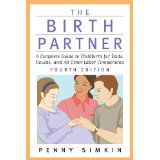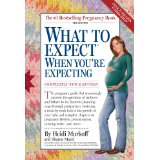*Name changed to make this less Google-able by my daughter’s future classmates. We used the name Equinox Namaste-Firestorm in the subject line of our birth announcement to get a laugh out of our friends and family (although, I’m sure at least someone was disappointed. If hadn’t been for Richard’s vetos she might’ve gotten a name like that from me!).
March 23 – March 27: 40 Weeks 0 Days – 40 Weeks 4 Days.
Forewarning: Those of you who’ve been following along with my pregnancy, may be looking forward to reading a story about a natural, hypnotic childbirth. If you’re limiting your exposure to only stories about that type of birth, this is not the one for you to read. This is not a story about a woman who remained calm, relaxed, graceful, or even positive during childbirth. That said, it’s not a horror story either; it was a normal birth and nothing went terribly awry. I look back on the experience with no regrets, and–now–feel incredibly positive and grateful now about how it went. If you’re okay with that type of story, please read on.
Last days of pregnancy
I was feeling antsy to get labor started in week thirty-nine, so you can imagine I was beside myself by week forty. I kept busy alternating swimming in the sunshine on one day (and, as a Canadian, being amazed that an outdoor pool was open in March) and practicing prenatal yoga the next. On my guess date (Monday) I treated myself to a comically large almond bubble tea smoothie (the place I went was automatically upgrading every order to their 32oz size that day. Nobody needs that much bubble tea! I drank it all anyway). That afternoon I had a prenatal massage with acupressure from Carole Moore, who has a track record for kickstarting labor. Sure enough, that night I awoke several times to sporadic contractions, but they were gone by the next morning. After swimming on Wednesday, I indulged in another bucket of bubble tea (the promotion was still on) and then got a pedicure. The women at the nail salon were impressed that I was out-and-about past my due date (little did any of us know I’d go into labor that very night). I knew that our baby’s middle name was probably going to be Firestorm, so when I saw the ostentatious orange and yellow glitter polish, I couldn’t resist. During my labor, several of the hospital staff commented on my glitzy pedicure, reminding me that everything I was going through was so we could meet our little Firestorm.

Wavering on my prenatal nutrition at 40 weeks.
Labor At Home
Typical labor is an ascent: contractions begin mild, short (thirty to forty seconds long), and widely-spaced (five to twenty minutes apart), and gradually progress to intense, longer (sixty to ninety seconds long), back-to-back (two to three minutes from the start of one to the start of the next). My labor was more of a relentless cross-country trek in which I didn’t know if the mounting intensity was due to progress or fatigue. I didn’t get to make cupcakes or do any watercolor painting because I either skipped typical early labor or slept through it. I woke up to regular contractions around 4:15 a.m. on Thursday, March 26th. I tried to sleep, but they were intense enough that I had to focus and use breathing techniques to relax, and there wasn’t enough time in between them to doze off.
I knew Richard would be able to help me most during labor if he got as much sleep as possible, so I wanted to delay waking him up until there was actually something he could do to support me. By 5:30 a.m., the sensation was intense enough that I was already gently shaking him awake to let him know that labor had definitely started, and it was coming on strong. He came out to the living room with me and started timing my contractions. We’d discussed that he wouldn’t tell me any numbers during the experience to keep me out of my neocortex, but later he told me they were thirty seconds long and about a minute-and-a-half apart (i.e. I got a minute off between contractions). In fact, that was the timing of my contractions for the next 26 hours of so.
We labored at home until around 7 p.m., and out of this fourteen-hour period, I only have about three hours of specific memories. There was so much repetition that, even in the moment, one contraction/rest cycle blurred into another. We began in the living room, where I alternated between two positions
- Kneeling in front of the couch so I could lean forward and rest my body weight on the cushion between surges.
- Side lying on the couch so I could look out the window.
When Richard first opened the curtains, I marveled at the deep orange hue of the sunrise shining against back fence, and remarked, “Just like Firestorm.” Richard wrote down some of his thoughts about the birth, and shared this memory:
One thing we were both able to enjoy, between contractions anyways, was the beauty of the moment. It was a gorgeous sunny day. We opened the drapes and the sun was coming up, and it was casting warm sunlight onto our back fence and overgrown green garden, which was bright and wet from the fog and dew. It was a beautiful day to be born. At one point, we were provided a brief respite from the intensity and duration and able to fall asleep on each other on the couch next to the beautiful scene outside… It was, in a sense, a very intimate and uniting experience for me. I was there for her when she really needed me, providing support for her in whatever way she needed it, whether it was food, massage, reassuring words, preparing the bath, or simply giving her a sip of water. I’m really happy and proud I was there for her.
I thought about making myself a soundtrack for labor ahead of time but I decided it would be a waste of time. I had no idea what I’d want to hear during labor. That intuition was spot on. After settling in the living room, I asked Richard to play an album I hadn’t thought about in years: Camaradas by Three Altos, which features amazing three-part harmonies. Richard and I learned the song “O Mama Bakudala” at a yoga retreat we did together shortly before getting engaged, and we still sing it together sometimes. “Camarada” I sang to Richard at our wedding. We listened to that album twice through, and then switched to Rachel Yellin’s Ultra Depth Relaxation and Birth Rehearsal tracks. These hypnosis tracks helped me soften. It felt like my contractions often started or ended in sync with Rachel’s cues. After we changed locations, we never ended up putting Rachel’s tracks back on.
Our doula, Britt Fohrman, was giving Richard advice over the phone, and suggested we try the shower. I’d been avoiding it because I didn’t want to be standing up, but Richard helped me set up by kneeling on towels so I could rest my forearms on the side of the tub. During contractions, he would hold my head between his arm and his waist, which felt so supportive and comforting. The soothing sensation of water cascading down my back made the contractions feel easier. The warmer the water, the better it felt. The downside of that (or, the upside for California’s drought) was I could only stay in the shower for so long before overheating.
After my first shower, we migrated to the bedroom, instead of back to the couch, where I spent some time side-lying with my Snoogle pillow. When I was in the bedroom, I felt the most supported and able to rest. Richard remarked later that as labor progressed, I spent more and more time in the bedroom, the most cave-like room in the house. My animal instincts must have been taking over.
We spent the day cycling through the living room, shower, and bedroom. Every time we changed positions, Richard would have to cart along plain water and coconut water, both fitted with bendy straws; a plate of sliced boiled eggs, mango pieces, and cheese; and a four-foot-tall oscillating fan. Between every contraction he would give me a bite of food and a sip of water. Normally, I’m not a fan of coconut water, but I thought my body might crave nutrition and hydration enough during labor to enjoy it (just like I savor Gatorade on a long run, even though it’s normally unpalatable). Nope, it was still awful. Richard made me have a sip every other contraction anyway.
By the afternoon, my experience had intensified. Richard shared this memory:
Barbie was vocalizing a lot, so we started saying lots of positive affirming things instead of just moaning, groaning or screaming. She had sent me and our doulas a list of positive affirming things that resonated with her the week before, so I was able to integrate those, some of the things from [our childbirth preparation class], and the doula’s advice into useful things to say during exhales. “Yessssss”, “I cannnnnnnnn”, and “Let gooooooo” were some of the best. “Let go of the sensation, let go of your body, let go of the baby, they know just what to do” was another good one. Every now and then I could work in a reference to meeting the baby, and it would get a small smile or a relaxed face.
I could really see the difference in her with and without this support. Without it, she would forget her breath, was more likely to just yell out, and was more visibly exhausted at the end. With it, she maintained a smooth rhythm and recovered faster, which mattered a lot with only 30 to 60 seconds between waves to recover.
During pregnancy I wondered which would be more intense: labor or running a marathon. I wish my current-self could go back and laugh in my past-self’s face for thinking the two would be comparable. Although I was in extreme discomfort when I ran the marathon that I barely trained for in shoes that were half a size too small, I still painstakingly ran the whole thing. During contractions, I couldn’t even walk let alone stand unsupported. Before experiencing it, I simply did not have the framework to imagine what the intensity of labor would be like. Now, looking back, I don’t even think I have the framework to fully remember what it was like. To everyone who warned me of exactly these things: I apologize for never genuinely believing you.
By three o’clock, my contractions started to feeling unmanageable. The coping techniques I’d been using were either not enough, or maybe I’d simply burnt out on them. I also have a vague recollection of being at just the right (or wrong, in this case) angle to see the clock on the oven, and how it did not seem to be progressing at all. I told Richard it was time to call the doula.
Britt arrived around 4pm, and we were in the bedroom. Richard shared this:
Britt was able to speak a lot better to Barbie than I was and got her into more powerful trance-like states, and switched her to some different poses that might help. Meanwhile, I was able to focus on physical touch and stroked her body in various ways. Things steadily got more intense over the next several hours. At the start, with Britt’s help, Barbie was able to really focus inward and became very still as she dealt with the surges.
I don’t remember much of what Britt said or did. I do remember ascending out of those trance-like states though. It felt like I’d fallen asleep, and I had no idea if 10 seconds or an hour had elapsed. There was a period where labor felt manageable again.
At some point I started shaking. It was like intense shivering, but I wasn’t cold. Britt told me that the shaking was the energy of birth, and to let it happen rather than resisting it. She kept telling me that this meant things were moving in the right direction, and internally I asked, “But when? How much longer?” I never voiced these questions, because I knew that Britt couldn’t answer them. Not even a midwife or a doctor could’ve. Another question I screamed internally when my experience became more intense was, “Why?!” I didn’t vocalize this because I already knew the answer was in who, what, and how: Equinox Firestorm being born vaginally.
We tried a couple new positions: on the toilet, kneeling in the shower with chest and arms on an exercise ball, standing bent over in front of the bathroom sink with my forehead resting against my hands on the counter. In the last position, I could see my sparkly toe nails and thought about meeting our daughter. Against the counter, I mimicked something I’d practiced in Britt’s prenatal yoga class: I squatted up and down during contractions, and chanted, “Down baby,” on my exhales. This foreshadowed the position in which I would push my baby out.
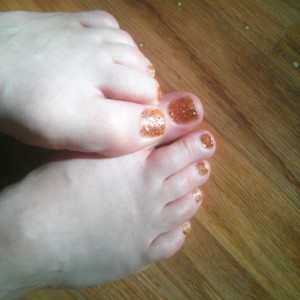
Glitzy Firestorm toes.
In the shower, Britt suggested I sit on the exercise ball, but I couldn’t handle the increased intensity of doing so. By the time I asked her to come I was already on the downslope to exhaustion. Perhaps earlier in labor I could have handled more intense positions that may have spurred labor to progress faster. Since the birth I’ve found myself wondering maybe if I’d asked Britt to come sooner, or maybe if we’d put Rachel Yellin’s tracks back on, or maybe if something else I would’ve been able to labor naturally for longer (or even have a completely unmedicated birth). But it’s not really worth musing over. As Rachel Yellin said repeatedly in our birth prep class, “Birth is mystery.” Maybe if I’d labored naturally for longer I wouldn’t have had the energy to push my baby out. It’s impossible to know. Also, my next birth will progress in its own unique way and may be nothing like this one. The one thing I’ll do differently next time is write down a clear list of birth techniques that resonated with me because I didn’t get a long enough rest during between contractions to think about trying anything different than what I was doing, let alone ask for help or support in doing so.
After a couple hours, we weren’t able to really keep her breathing or focused through the powerful surges. While I think she had enough physical energy (we had been feeding her a steady stream of food and drink), she was definitely burning out emotionally. She started saying “I can’t do this” and “No” pretty often as her faith waned and the surges overwhelmed her. She cried and sobbed a lot. This was really tough. There wasn’t much we could do, and it started to feel like I was forcing my will on her to keep going. It felt very touch-and-go. Some surges she would breathe through, but more often she’d cry, sob, or lose her breath.
In our last round in the shower, I got a subtle sign that my epilepsy might be starting to get aggravated. It takes a lot for me to have a grand mal seizure, and the flutter I experienced in my eyelids was a long way from that (maybe it wasn’t even epilepsy-related), but it still shook my confidence and impaired my ability to completely relax. When intense sensation meets fear, it becomes unendurable pain. I became less and less able to handle the contractions. When I dragged myself back into bed to labor there, I had a flashback to a conversation I had in which one of my yoga students was telling me what a great experience she’d had with her epidural when she gave birth many years ago. She’d been trying to labor drug-free, and when she caved and got the epidural, she thought, Wow, why didn’t I do this sooner? I told her it was important to me to labor naturally, and added, “But if I get to the point that I’m absolutely suffering instead of softening, I’ll request pain medication.” Curled over in fetal position on the bed, I thought, I’m suffering.
I told Britt it was time to go to the hospital, and she diligently tried to tease out my reasoning and make sure it was actually what I wanted. I told her I needed to sleep. My epilepsy, or at least my anxiety about my epilepsy, combined with the relentless and mounting intensity was too much for me to keep meeting. In our prenatal meetings, we’d discussed that if my epilepsy became a factor we’d head to the labor and delivery ward. Britt and Richard started gathering up what we needed for the hospital. Right before we left around 7 p.m.:
As I walked into the bedroom where Barbie was, I heard the distinct sound of chunky water dumping into a bucket. When I turned the corner, my mind couldn’t quite comprehend the scene. Britt and I were so proud of feeding Barbie and getting her liquids the whole time….Barbie returned the favor by vomiting it all out everywhere. The bed, the floor, the surge protector, all the cables, the night stand, and some into the trash. 12 hours worth of eggs, mango, and coconut water all over. I think this is the reason why Britt drove us to the hospital with me and Barbie in the back, and a gallon sized plastic ziploc just in case.
Labor in the Hospital
When we got to the hospital Britt asked me if I wanted to walk or get a wheelchair, which in my mind was a ridiculous question; of course I wanted a wheelchair, I was done. We went up to the labor and delivery floor, where they got us into a triage room. They had to monitor the baby and me for twenty minutes, which felt like it lasted forever. Richard told me later that one of the nurses watching the monitors called my contractions inhumane (although maybe the fact that I was bawling through every surge influenced her opinion). A pregnant friend of mine told me she was hesitant to tour the labor and delivery ward of her hospital for fear of hearing women screaming during labor. I responded that I didn’t think women really made as much of a ruckus in real life as they did on TV. Well, I was wrong. Hopefully no one was touring the floor when I first arrived.
They put the head of the bed on an incline so I could kneel with my forearms at the top of the bed. They also did a vaginal exam, and asked me if I wanted to know how dilated I was. I don’t know why I bothered finding out; I’d already made up my mind. The only way I was going to skip out on that epidural was if they told me I couldn’t get it because it was time to push. I was six or seven (out of ten) centimeters dilated, which felt perfect. I was happy that all those hours laboring had been to some avail and grateful that I’d come to the hospital for some relief because there was still a ways to go (although it’s impossible to know how fast a cervix will dilate. I could’ve completed those last three centimeters in an hour or in two days and an hour).
As they were monitoring me, someone brought up fentanyl, an opioid they can give laboring women so they can get a couple hours of sleep and then come back strong once it wears off. I read the Wikipedia article on it later, and apparently it’s fifteen to twenty times more potent than heroin. I’d heard that it didn’t necessarily do much for the pain, but it made you care about the pain less. They said I could get a dose to take the edge off until I could get the epidural. At first, I was adamant that I did not want fentanyl. I did not want to feel high. The idea of being in an altered headspace freaked me out. However, at the peak of a contraction someone said the right thing and I agreed to it. They injected it into my IV, and as my next contraction faded, I got sleepy and melted down onto the bed. I remember thinking woozily, The fentanyl was a good decision.
I had more time than usual to think about what I was going to write for this blog post during the constant cycle of breastfeeding, changing diapers, soothing, and drifting in and out of sleep-when-the-baby-sleeps naps since Equinox was born–it doesn’t leave much time to actually write. During a breastfeeding-induced oxytocin high (which was remarkably similar to a fentanyl high in our first blissful week postpartum) I was contemplating Equinox’s birth story and toying with drawing an analogy between my labor and playing Super Mario Brothers (it was a long, steady course, the regular closely-spaced contractions were like flying turtles, there was a princess at the end…). Ultimately I abandoned the analogy because the music was all wrong. However, I stand by one piece: when you get your magic mushroom of an epidural, you swell up to twice your normal size. Luckily someone warned me ahead of time that when you ask for an epidural, it takes about forty-five minutes to actually get it because they have to spend that time pumping the mama full of IV fluids first as a precautionary measure. Britt took some photos during my labor, and I can’t believe how puffy I was!
I don’t remember what the anesthesiologist’s name was, but in my mind I call him Dr. Mike. Postpartum, Richard confirmed that—it wasn’t just the fentanyl—Dr. Mike was just as I remembered him:
The anesthesiologist looked like a TV doctor on a soap opera. I’m not kidding. He was a good looking guy, obnoxiously loud, and had a swagger to him. In retrospect, it was comical with how he burst in the door with his little cart of drugs and declared how his medicine (always “medicine”, never a drug by name, as if it was magic elixir) was going to make her feel all better.
To Dr. Mike’s credit, the epidural was a breeze, and once it set in, I was able to get several hours of sleep. Well, several hours of sleep at fifteen-minute intervals. They fit me with a blood pressure cuff that automatically whirred tight every fifteen minutes to make sure my blood pressure was still in the safe range. I wasn’t as completely numb as I thought I’d be. I could still wiggle my toes, and I felt it when my mucus plug came out and when my water broke in the middle of the night. However, I was numb enough that if I wanted to roll over to my other side, I had to press my call button so the nurses could come help me.
The midwife, Becca, told me that when it was closer to the time to push, I’d start to feel pressure breaking through the epidural. During the night, I started feeling some sensation again. Becca checked me and found out I was 9.5 centimeters dilated and there was still an unbroken piece of my bag of water covering the baby’s head. Becca said we could 1) use the drug pitocin to augment contractions and speed things up (she thought that was overkill), 2) break the forebag so the baby could descend more easily, or 3) watch and wait. After taking some time alone to discuss our options with each other and Britt over the phone (she’d gone home to rest while we did), Richard and I chose to break the forebag.
I slept a little longer before I started shaking with the energy of birth again. Becca offered to check my dilation, but I chose to wait. Both she and I were on the same page that we wanted to delay active pushing not only until I was ten centimeters dilated, but until the baby had descended most of the way via the involuntary contractions of my uterus, and I didn’t think I was experiencing intense enough sensation for that to be the case.
However, I told Becca the shaking was making me nervous because of my epilepsy. She had the most amazing reply, and I feel overwhelmed with gratitude I got this response in a hospital setting. She could have reacted, “Oh my God, I’ll install the padded bed rails and push a dose of Keppra immediately!” But instead, she said something like this: “Pay attention to the shaking for a moment. Can you feel that it’s different from the shaking you get when having a seizure? Yes? Good. Keep tapping into that.” That was exactly what I needed to hear to keep feeling empowered and reclaim ownership of my body.
I have no concept of time, but well before dawn sensation started to get overwhelmingly intense and I began to get an urge to push. It wasn’t breakthrough pressure; the epidural had worn off. Mentally, I had cut a deal with the pain that if I held out until I got the epidural it would go away forever, so I was not open to its return. Becca checked me, and I was ten centimeters dilated, but the baby hadn’t descended. That meant it was safe for me to push, but ill-advised because there was such a long way to go that I would get exhausted actively pushing the whole time.
They called Dr. Mike to come back and reinstate his “medicine” so I could wait out the baby a little longer. In the meantime, I was having a hard time softening to the pain and was getting increasingly agitated by the delay. A nurse came in and told me Dr. Mike was on his way and wanted me to “press the button” twice until he could get there. “Where’s your button?” she asked. I was confused and pointed her to the call button that summoned the nurses. “No, the button for your epidural that gives you a dose of medicine.” What?! There’s a button??? It turned out I didn’t have one installed. With how wildly uncomfortable I was, I was furious at Dr. Mike for stiffing me on the button.
The only thing that made be feel better was to push, so Becca coached me through pushing with one knee pulled into my chest. During contractions, she had me take a deep breath, hold it for ten seconds as I pushed, and then release. I could fit in three or four cycles per contraction. Everyone knew that it was just a coping strategy and I wasn’t actually going to push the baby out in that moment, but in retrospect it was a good practice session. I learned the breathing and how to engage in a productive way. Still, I kept asking when the anesthesiologist was going to get there and as time went on, I started sobbing, “He’s not coming! He’s not going to come at all, is he?” Richard called Britt to come back and support me, and she made it there from home before Dr. Mike arrived. At some point Britt remarked that I’d gotten the epidural at the right time as it hadn’t slowed down or impeded my labor at all.
Eventually the nurse came back in with instructions on how to give me a dose or two more until Dr. Mike could get there. Despite the proud look of accomplishment on the nurse’s face, I don’t think it worked. Finally, over an hour after the nurses called, Dr. Mike showed up in his charismatic, boisterous manner, and showed me a big syringe of “more powerful medicine” that would make all the sensation go away for a little while, then he’d give me a couple more doses of the regular epidural. After all that set in, all my fury toward Dr. Mike was forgiven and I got a couple more hours of sleep.
Childbirth
When the epidural next wore off in the morning, Becca checked me and let me know that the baby had descended much more than before and I could push if I wanted to. I wasn’t about to wait another hour for Dr. Mike to come dose me up again, so I started pushing with Becca and Britt coaching me.
At first I was laying on my back and hugging one knee into my chest with the support of a Becca, Britt, or a nurse. Then they set up the squat bar on the bed and looped a sheet over it so I could pull myself up into a crunching position and get more power. Maybe because the squat bar was right there in front of me, I had a moment of clarity and thought, This is stupid. Why am I trying to push my baby out on my back? I gasped, “I need to be in a position where gravity can help me.” Someone expressed doubt about me being able to move with the epidural, and I don’t think I responded aloud, but in my mind I screamed, There’s no fucking epidural! It has long since worn off! I have full and complete function in my legs! After all was said and done, one of the nurses discovered that the epidural tube had actually popped out of my back during all the movement I did pushing, so by the time the baby was coming out, there was literally no epidural.
Britt and Becca helped me into a squatting position and got Richard to sit behind me on the bed. I’d never thought to tell anyone this, but I’d always visualized Richard sitting behind me whispering in my ear as I gave birth, so this was absolutely perfect. He breathed with me through every surge and then between them he repeated affirmations to me and told me I was amazing.
I felt most productive when I pushed up into the squat bar as hard as I could with my hands. Becca told me she would give me a dollar for every time I pooped, and it’s true, it does feel pretty much the same as pooping. At some points I unreservedly pushed back into Richard as hard as I could. Later, he told me at times I squished him so flat he couldn’t breathe. He was a total champ and rode it out without complaint. Honestly, when I think about all I have put this man through over the years and how he has stepped up, I’m overwhelmed with gratitude and joy to have him as a birth partner, a husband, and the father of my child.
I think I pushed for a little over an hour. I’ve heard many times that pushing is a relief because you actually get to do something. And it was at first. Then the baby’s head started to emerge. They had me reach down and feel her head a couple times, but it wasn’t progressing nearly as quickly as I wanted it to, so I stopped feeling for it. They offered to hold up a mirror so I could see my progress, but I thought it would just freak me out.
The hardest moment of my life to that point was when Equinox’s head was 20% of the way out. Then after the next contraction when her head was 30% of the way out, that was the hardest moment of my life. 40% was harder still. At all of these points I knew for a fact that I couldn’t go on. I was done. I was sobbing, “I can’t! I can’t.” But I also knew for a fact that there was no choice, and that I had to. Britt made this concrete for me. Everything about that room was a little hazy, but then Britt got her face right in front of mine, and that image was crystal clear. I don’t remember her exact words, but she said something like. “Barbie, this is it. There is no more fentanyl, there are no more epidurals, there is no choice. The only thing you can do is push your baby out. Now’s the time to just fucking do it. Be a warrior.” The last phrase was said subtly softer like the toughest yoga teacher you’ve ever been to; it gave me the image of warrior pose rather than a soldier. The rest was said like a no-nonsense boot camp drill sergeant, and that was exactly was I needed in that moment.
When I read or heard about tearing during pregnancy, it always seemed to be presented as something that happened to women, completely outside of their control. To an extent that’s true. Equinox surprised everyone by coming out “sunny-side-up” (face toward the front of my body). When babies are born in this position (occiput posterior) they are much harder to push out (thank you Preggo Pilates for giving me the strength) and mothers are much more likely to tear, so there may have been nothing I could do to avoid it. However, it didn’t just happen to me. To get my baby out, I actively pushed so hard that my baby tore through my flesh. Nothing prepared me for how willful this would be.
I know I’m supposed to think that everything about birth is beautiful and empowering, but I still think consciously ripping apart my own skin and muscle tissue was a little messed up. That night, when the memory was still visceral, I was afraid to fall asleep for fear I’d dream about it. However, the next day, I still remembered that it was hard, but I’d let go of (or repressed) the raw, kinesthetic memory of what it was like. All of this said, the purposefulness of pushing Equinox out outweighed the trauma. Immediately after birth, instead of thinking, Wow, I am never going to do that again, I remember distinctly thinking, Wow, that is going to be so hard to do again next time.
Thankfully, after the baby’s head was out, the rest of her emerged easily. Immediately after Equinox was born, they placed her on my chest. The first thing I said was, “She’s so big.” I could not believe that she been in my body, let alone passed through it. A couple months before I gave birth, Richard and I visited a friend and her month-old baby who had been born six weeks premature. That was the size I’d been visualizing, and my baby had to be at least fifty percent bigger!
Equinox and I didn’t get much peace. She was breathing and making little noises, but because she didn’t immediately cry loudly, there were four frantic hands, poking her, prodding her, and bulb syringing her the whole time she was on my chest. It was overwhelming. After honoring my wish for delayed cord clamping they clamped and cut the cord, and whisked her away to make sure she was breathing okay. Richard went along with her so she wouldn’t be alone. Our birth preference was to delay all newborn procedures until after the first breastfeeding session, but when Richard turned his back for a moment to update me, they gave her the vitamin K shot after he’d expressly told them to wait (they said something about wanting to make her cry and achieving both that and the injection at once). They took time to weigh her too, which obviously wasn’t urgent. Richard’s thought was:
I think they just have a big checklist of all the stuff they have to do, and since things are either done or not done, “wait” isn’t really captured by their checklist.
A friend of mine shared her birth story in which her baby was born prematurely and they missed out on that whole “Golden Hour” of skin-to-skin contact with baby on mama’s chest (I’d like to rename our first hour with the baby the Golden Shower Hour since Equinox peed on me and pooped on both Richard and me multiple times within that span). My friend told me in retrospect it seemed ridiculous that she was so worried about that first hour, because there was so much more time to bond with the baby after he was stable. Also, they had no problem breastfeeding despite not initiating it until quite some time after birth. I was grateful to have heard her story because when the nurses and doctor finished up with the baby and brought her back to me, I felt too overwhelmed to take her. I still had to deliver the placenta and get stitches—I wasn’t feeling relaxed and ready to be present with my baby. Someone suggested that Daddy do skin-on-skin contact with the baby, and he didn’t need to be asked twice to fling his shirt off. It was so sweet and heartwarming to see the two of them bonding while I was finishing up with what I needed to do.
It’s worth noting that I chose to get postpartum pitocin to help my uterus clamp down and release the placenta without hemorrhage (this was the one drug I had been planning to get all along unless I had an absolutely average birth—I didn’t want the thought of bleeding out taking up head space). One of the purported side-effects of postpartum pitocin is that it can interfere with the mother and baby’s bonding. Maybe it contributed to my need for space, maybe I was just plain overwhelmed from going through the most arduous experience of my life. However, I can second my friend’s experience: there was so much more time and opportunity than that first hour to fall madly, deeply, obsessively in love with my little one, and she’s been such a great eater that the pediatrician is letting her skip her one-month appointment.
When the placenta came out all in one push, I said the same thing as I did about the baby: “It’s so big.” I still can’t believe all that stuff was inside of me. Beforehand I’d told everyone, “Don’t show me the placenta, I don’t want to see it, don’t bring it close to my face.” When I saw how big it was, I immediately thought, WTF, lemme get a closer look at that thing! Britt showed me how the bag of waters was still attached so I could visualize where the baby had been all this time, and that the veins on the baby’s side of the placenta formed a tree shape–she called it the tree of life.
I’ve had several people tell me the stitches were the most painful part of childbirth, but they weren’t too bad for me. Because the epidural was long since gone, they used several lidocaine injections to numb the area. The hardest thing about it was how annoyingly long it took. I felt like the obstetrician and the new midwife who’d just come on shift were being overly social across my perineum as he explained the stitches he was doing to her, but I was probably just anxious to be done. I asked them how many stitches I was getting, and they said it wasn’t so much individual stitches as it was one long thread that followed an atypical (but nothing to worry about) path. The gesture the OB made with his hand made it look like a winding trail that hooked around at the end. Yikes. It was a second degree tear, which is the most common type. The recovery time was much longer than I expected: they recommended I avoid exercise and keep my legs together—both figuratively and literally—for six weeks!
Finally, all the unpleasantries were out of the way and I was ready to have my baby back on my chest. I think it was Britt who asked if we wanted to do the milk crawl. I enthusiastically agreed and asked her to show me what to do. We moved Equinox down onto my belly and I put my hands under her feet. She pushed with her strong little legs against my hands and started crawling up toward one of my breasts. One of the reasons we delayed the antibiotic eye ointment was so that she could clearly see the darker nipple with respect to the rest of the breast. Without any guidance from us, she found her way up to my nipple and instinctively latched on. Richard reflected:
We watched the baby do the milk crawl, and I had tears in my eyes. It was a really beautiful thing to watch.
Britt snapped a picture of Equinox and me in this moment, and Equinox’s facial expression is one I’ve seen many times while breastfeeding since: instinctual, animalistic, feral. Just like my birth affirmations say, my baby knows exactly what to do. A childbirth technique I could never really connect to was to use the baby as an inspiration, but I finally get it now. In one sense Equinox is totally helpless, but in another sense she is incredibly intelligent, fierce, and tapped into an intuition and instinct most of us have forgotten how to access. Next time I give birth, I know both Equinox Firestorm and the little one to come will be some of my most powerful inspirations.
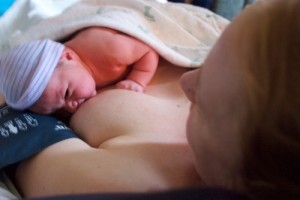
Equinox Firestorm’s first attempt at a latch at the end of her milk crawl. (Photo credit: Britt Fohrman)






